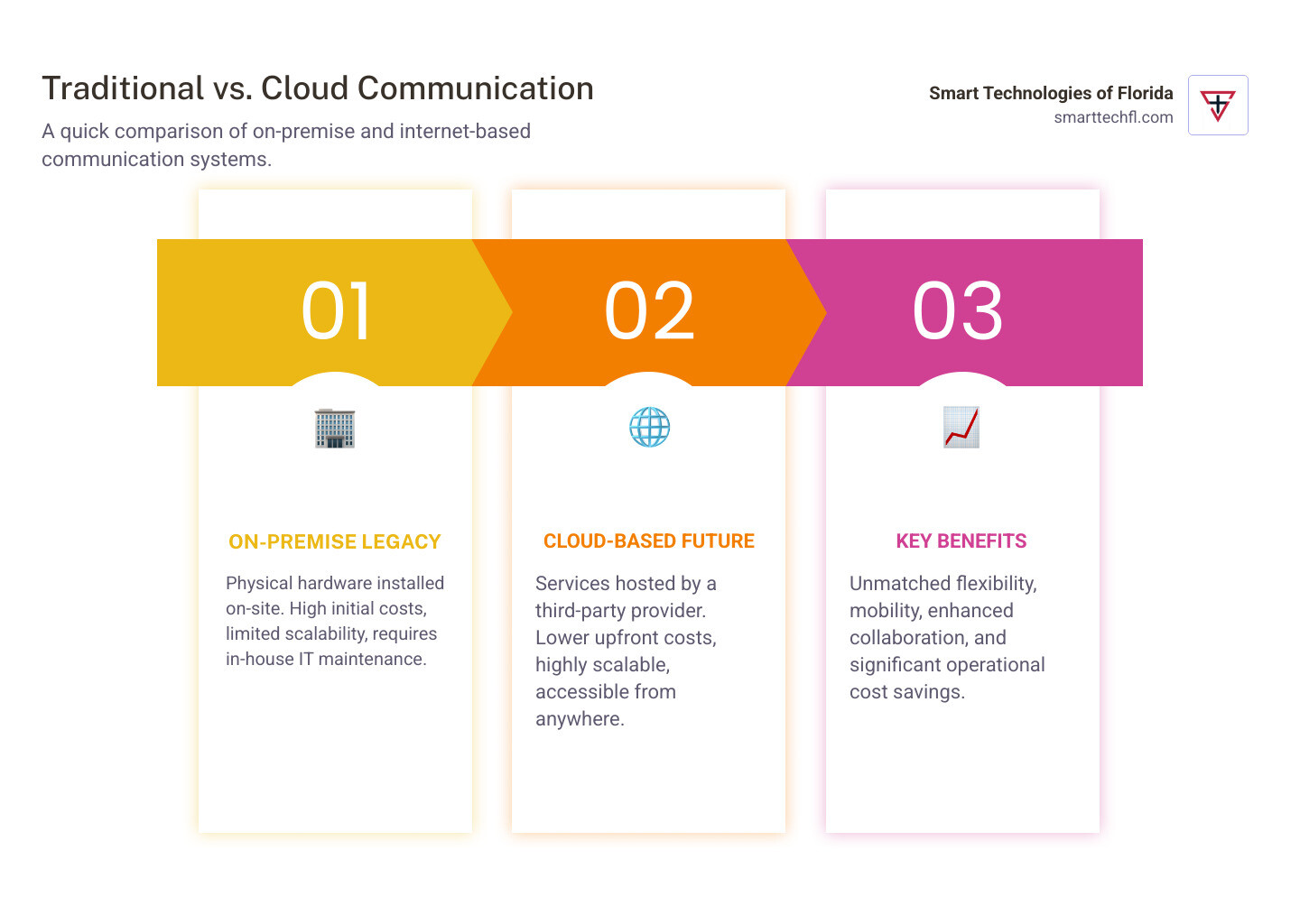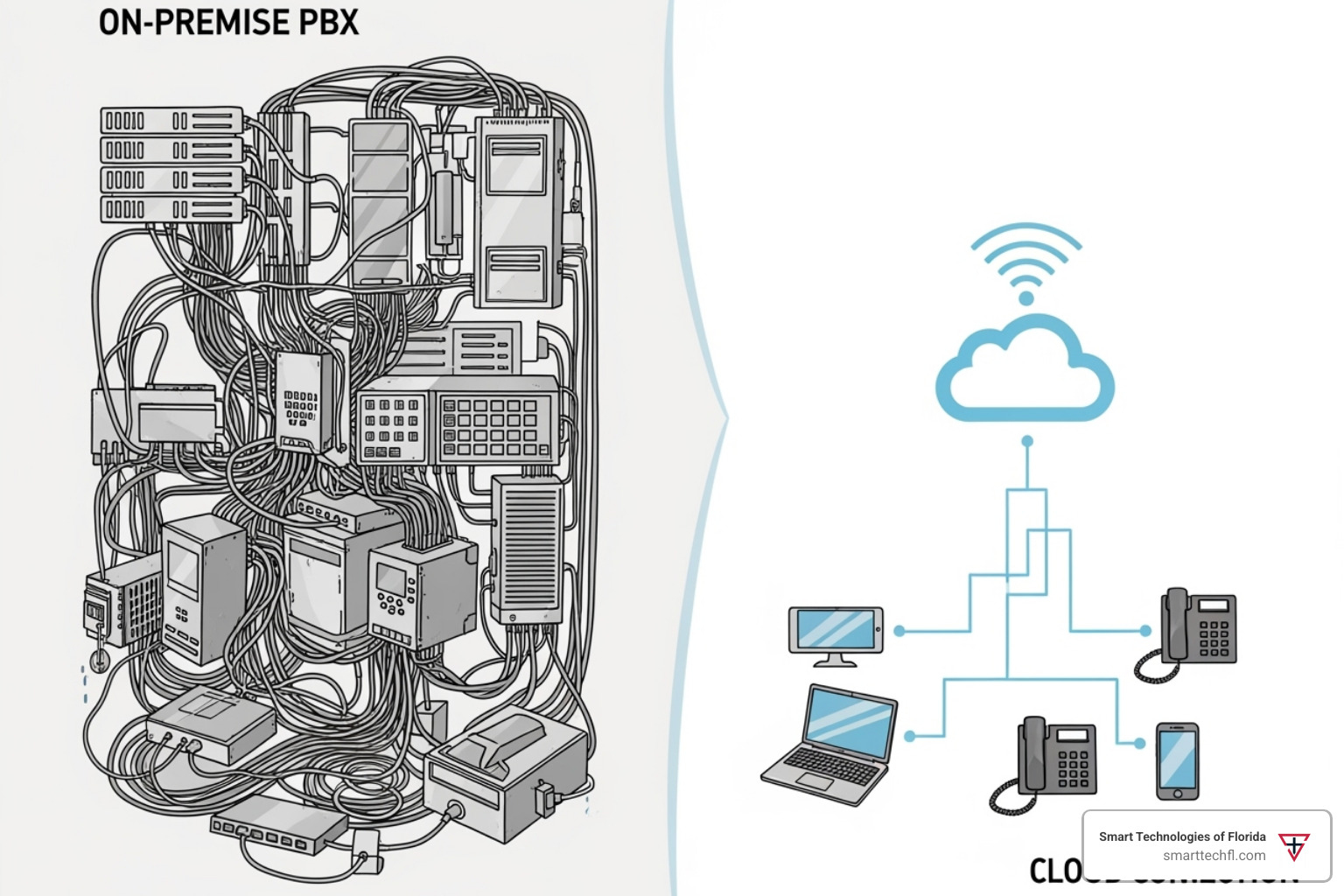Cloud Communication Platforms 101: Talking in the Clouds Made Easy
A cloud communication platform is an internet-based system that handles all your business communications. Think of it as moving your phone lines, video calls, and messaging tools off your office walls and into the internet. Instead of bulky, expensive equipment on-site, a third-party provider manages everything for you, accessible from anywhere.
Here’s the quick take:
- What it is: A web-based solution for all your business calls, messages, and meetings.
- How it works: Services are hosted by an external provider, accessed securely over the internet.
- What it replaces: Traditional, on-premise phone systems and separate communication tools.
- Key benefit: Gives you the freedom to work from anywhere, on any device.
This shift isn’t just about new technology. It’s about adapting to how we work today. With more and more people looking for flexible work options, businesses need tools that support this. In fact, research shows that 87% of people would choose flexible work if they could. Cloud communication platforms make this possible. They empower your team to stay connected, no matter where they are.
Gone are the days when your business communication was tied to a physical location. Welcome to a world where your communication tools are as flexible as your team needs them to be.

What Are Cloud Communications and How Do They Work?
At its core, a cloud communication platform is a suite of internet-based tools for your business’s voice and data communications. Instead of physical hardware in your office, services are hosted by a third-party provider on remote servers. All applications, switching, and storage are managed externally and accessed securely over the internet.
Similar to cloud services like Google Drive or Microsoft 365, business communication is shifting to the cloud. This digital change allows for seamless communication without the complexities of on-premise setups, like those used in our Office Phone System VoIP solutions. When you use a cloud communication platform, your data travels over the internet to the provider’s secure data centers, which house the servers and applications that process your communications. You can access these resources from any internet-connected device, anywhere. For more on the underlying technology, see our guide to Cloud Services – Cloud Computing Solutions.
From On-Premise to On-Demand
For decades, businesses used traditional Private Branch Exchange (PBX) systems. These required bulky, expensive on-site hardware and specialized IT staff for installation and maintenance. Adding new lines or features was costly and complex.
The internet changed this model. With a cloud communication platform, the PBX becomes a virtual phone system managed off-site by your provider. All routing, call management, and features are delivered from the cloud. You only need an internet connection and a compatible device—like a desk phone, softphone, or smartphone—to access your communication suite.
This on-demand model frees businesses from the high costs and operational burdens of managing their own infrastructure. It also allows internal IT resources to focus on core business activities instead of troubleshooting phone lines.

Key Differences: Cloud Communications vs. Cloud Telephony
While often used interchangeably, there’s a subtle yet important distinction between “cloud communications” and “cloud telephony.” Understanding this clarifies the broader capabilities of a comprehensive cloud communication platform.
Cloud Telephony refers specifically to voice services. It’s the direct replacement of conventional business telephone equipment, like a traditional PBX, with a third-party Voice over Internet Protocol (VoIP) service. It focuses on enabling phone calls over the internet, with features like call routing and voicemail, replacing on-site hardware. If your main goal is to replace your old phone system with an internet-based one, you’re looking at cloud telephony. Our detailed article, What is Cloud Telephony?, digs deeper into this specific aspect.
Cloud Communications, on the other hand, is a much broader term. It includes cloud telephony but is much broader, encompassing all internet-based voice and data communications. It integrates various channels and applications into a single, unified platform. Beyond just phone calls, it includes:
- Video conferencing
- Instant messaging (IM) and chat
- File sharing and document collaboration
- Email hosting
- Contact center functionalities
- SMS and text messaging
- Presence management (seeing who’s available)
Essentially, cloud telephony is one component of cloud communications. A full cloud communication platform unifies these tools to streamline workflows, improve collaboration, and provide a consistent user experience, making it a more comprehensive solution.
Key Components and Types of Cloud Communication Solutions
A powerful cloud communication platform is built from several core technologies. Understanding these components reveals the flexibility and power these platforms offer your business.

At its heart, any modern cloud communication platform aims to provide seamless, integrated communication. Let’s peel back the layers and find the primary technologies that make this possible, along with the different ways these solutions can be set up to perfectly fit your unique business needs.
The Building Blocks: VoIP, UCaaS, and CPaaS
These three acronyms are the fundamental layers that create a comprehensive cloud communication platform:
- Voice over IP (VoIP): This is the foundational technology that converts your voice into digital packets and sends them over the internet instead of traditional phone lines. VoIP makes calls cost-effective and accessible from any internet-connected device.
- Unified Communications as a Service (UCaaS): UCaaS bundles multiple communication and collaboration tools into a single cloud-delivered platform. It integrates voice, video conferencing, instant messaging, file sharing, and presence status into one interface to simplify workflows and boost collaboration.
- Communication Platform as a Service (CPaaS): CPaaS provides developers with APIs and SDKs to embed communication features (like SMS alerts or video calls) directly into existing applications and business processes. This allows for the creation of custom communication experiences custom to specific business needs. Learn more in our article on CPaaS Solutions for Business Communication.
When these powerful building blocks come together, they create a cloud communication platform that’s rich, integrated, and incredibly flexible, ready to adapt to whatever your business throws its way.
Deployment Models: Public, Private, and Hybrid Cloud
There are different models for setting up your cloud communication platform, each with its own benefits regarding cost, security, and control.
- Public Cloud: The most common model, where a provider delivers services over the public internet. Resources are shared among multiple organizations (multi-tenant), offering high scalability and cost-effectiveness with a pay-as-you-go structure.
- Private Cloud: The communication infrastructure is dedicated to a single organization. It can be hosted on-premise or by a third party in a separate environment. This model provides maximum control and security but at a higher cost and with more management overhead.
- Hybrid Cloud: This model combines public and private clouds, allowing businesses to keep sensitive data on a private cloud while leveraging the public cloud for scalability and less critical communications. This approach offers a balance of flexibility, cost-optimization, and security.
The best deployment model depends on your specific needs, budget, data sensitivity, and any industry regulations you must follow.
| Feature | Public Cloud | Private Cloud | Hybrid Cloud |
|---|---|---|---|
| Cost | Low (pay-as-you-go, shared resources) | High (dedicated infrastructure) | Moderate (mix of shared and dedicated) |
| Security | Good (provider managed, but shared environment) | Excellent (dedicated, highly controlled) | Flexible (can secure sensitive data privately) |
| Control | Low (provider manages infrastructure) | High (full control over infrastructure) | Moderate to High (control over private portion) |
| Scalability | Excellent (on-demand, virtually limitless) | Good (requires pre-provisioning or expansion) | Excellent (leverages public cloud for bursts) |
| Management | Low (provider handles maintenance) | High (internal IT team or dedicated vendor) | Moderate (requires integration and orchestration) |
The Transformative Benefits for Modern Businesses
Embracing a cloud communication platform is more than a system upgrade; it’s a fundamental shift that empowers your team and positions your business for growth. The benefits extend beyond simple connectivity to include financial health, employee satisfaction, and stronger customer relationships.

These platforms drive efficiency, reduce costs, and cultivate a more connected and productive workforce. Curious to dive deeper into these game-changing benefits? We’ve got you covered in our article on Cloud Business Communications Benefits.
Opening Up Flexibility and Mobility for a Hybrid Workforce
Hybrid work models are now standard, and employees demand flexibility. Businesses that offer it gain a competitive advantage in attracting and retaining talent. Research shows 87% of people prefer flexible work, and 31% of talented individuals leave jobs that lack it. This makes flexibility a critical business factor. You can learn more about this trend from McKinsey’s research on 87% of people.
A cloud communication platform is the foundation for a flexible workforce. It empowers your team to work from anywhere with seamless access to calls, messages, and meetings. Employees can use any device—desktops, laptops, tablets, or smartphones—as an extension of the office system. This flexibility boosts employee satisfaction by showing trust and value, which leads to higher morale and reduced turnover.
By enabling genuine mobility and accessibility, a cloud communication platform helps your business meet employee expectations and maintain smooth operations, regardless of where your people are physically located.
Driving Cost Savings and Operational Efficiency
One of the most impactful benefits of a cloud communication platform is significant cost reduction and improved operational efficiency, especially for small and medium-sized businesses (SMBs).
- Reduced Capital Expenditure (CapEx): Eliminate large upfront investments in PBX hardware, servers, and wiring. Cloud communications shift this cost from a major capital expense (CapEx) to a predictable operating expense (OpEx).
- Lower Maintenance Costs: The provider handles all maintenance, updates, and repairs, eliminating surprise costs and freeing up your IT team for strategic projects.
- Predictable Monthly Billing: Subscription-based models provide clear, consistent monthly costs per user, simplifying budgeting and avoiding hidden fees.
- IT Resource Savings: Offloading infrastructure management to an expert allows your IT staff to focus on core business functions, optimizing efficiency.
- Scalability Without Penalty: Easily adjust user counts and features as your business needs change. You only pay for what you use, ensuring cost-efficiency.
These factors create a more cost-effective, reliable, and secure communication environment. Want to learn more? Our article on Cloud Voice Services: Cost Benefits Explained dives deeper into these savings.
Enhancing Collaboration and Customer Experience
Beyond cost savings and flexibility, a cloud communication platform transforms how teams collaborate and connect with customers.
- Unified Platform: By integrating voice, video, chat, and file sharing into one interface, these platforms eliminate communication silos. Teams can switch between channels seamlessly, keeping projects flowing without searching across multiple apps.
- Real-Time Communication: Features like instant messaging, presence indicators, and one-click video conferencing encourage spontaneous collaboration and faster decision-making, regardless of location.
- CRM Integration: Deep integration with CRM systems provides a 360-degree view of the customer. Sales and support teams can see a customer’s full history before an interaction, enabling personalized service.
- Advanced Customer Experience Tools: Modern platforms improve the customer experience with omnichannel support, AI-powered assistance for 24/7 service, customer journey automation, and conversation intelligence to analyze calls for valuable insights.
By streamlining internal communication and enabling a more responsive approach to customer interactions, a cloud communication platform becomes a powerful tool for enhancing both productivity and satisfaction. Find even more about these incredible benefits in our guide to Unified Communication Platforms: Top Benefits.
Choosing and Implementing the Right Cloud Communication Platform
Choosing the right cloud communication platform is a critical decision that will become the backbone of your business operations and customer interactions. A thoughtful, step-by-step approach is key to selecting a solution that fits your long-term needs.

Here at Smart Technologies of Florida, with over two decades of experience, we guide you through this process with clarity and expertise to find a solution that aligns with your unique business goals. Our Cloud Communication Platforms Guide offers an even deeper dive into this important topic.
Step 1: Assess Your Business Communication Needs
Before evaluating providers, first understand your own business needs. This internal assessment is the foundation for making the right choice.
Consider these key questions:
- User Count: How many current users will need access? Account for future growth or seasonal fluctuations.
- Required Features: Identify must-have tools (e.g., voice, video, messaging, contact center) versus nice-to-haves to avoid paying for unused features.
- Integration Needs: List essential integrations with your existing software, such as CRM, ERP, or helpdesk systems.
- Budget Constraints: Determine a realistic budget for both initial setup and ongoing monthly fees.
- Future Growth Plans: Select a platform that can scale with your business over the next 1-5 years.
- Compliance and Security Needs: Identify any industry-specific regulations (e.g., HIPAA, GDPR) that require specific security or data residency standards.
Getting a clear picture of these points will help you focus on solutions that truly fit your requirements.
Step 2: Evaluate Key Features and Provider Reliability
With your requirements defined, you can evaluate potential providers. Look past marketing and dig into core features and provider reliability.
Here are essential qualities to look for:
- Comprehensive Communication Tools: Look for an all-in-one solution with integrated voice, video, messaging, and file sharing. Key features include call management, screen sharing, and presence.
- Unified Communications (UC) Capabilities: Ensure the platform provides a single, intuitive interface for all communication channels.
- Integration Capabilities: Verify that the platform integrates seamlessly with your critical business applications (CRM, ERP, etc.).
- Scalability Options: Confirm the platform can easily scale users and features to accommodate business growth.
- Uptime Guarantee (SLA): A reliable provider must offer an SLA with high uptime (e.g., 99.999%) to ensure system availability.
- Customer Support: Evaluate the provider’s support options. Is 24/7 support available via phone, chat, or email?
- User-Friendly Experience: The platform should have an intuitive interface to ensure quick user adoption with minimal training.
- Reporting and Analytics: Check for robust analytics to monitor performance and gain insights into communications.
- Global Reach & Support: For international operations, ensure the provider has a global presence and multi-language support.
Understanding these terms is simpler with a helpful Cloud Communications Service Provider Glossary.
Step 3: Prioritize Security and Compliance
Security and compliance are essential when entrusting a provider with your business and customer data. A provider’s commitment to security measures and regulatory standards is critical.
Prioritize the following:
- Data Encryption: Ensure all data is encrypted both in transit (during calls/transfers) and at rest (on servers).
- Secure Data Centers: Verify the provider uses physically secure data centers with surveillance, controlled access, and redundancy. Check for data residency options if required.
- Compliance with Industry Regulations: The provider must comply with relevant regulations for your industry. Key standards include:
- HIPAA (Health Insurance Portability and Accountability Act)
- GDPR (General Data Protection Regulation)
- SOC 2 (Service Organization Control 2)
- ISO 27001
- PCI DSS (Payment Card Industry Data Security Standard)
- Access Controls: Look for strong authentication methods like multi-factor authentication (MFA) and role-based access controls.
- Disaster Recovery and Business Continuity: The provider should have a robust plan with data backups and redundant systems to ensure service continuity.
- Regular Security Audits and Updates: The provider should conduct regular security audits and apply timely patches to address vulnerabilities.
By carefully checking a provider’s security and compliance, you can reduce risks, protect sensitive information, and ensure your communication practices meet all legal and ethical standards.
The Future of Business Communication is in the Cloud
The evolution of the cloud communication platform is accelerating, driven by Artificial Intelligence (AI). The future lies in an intelligent cloud that makes business communication more personal, efficient, and insightful.
Here’s a look at what’s on the horizon:
AI is becoming a core component of communication systems, with applications like:
- AI-Powered Agents: Virtual receptionists and voice agents can handle a high volume of calls, answer common questions, and provide 24/7 customer service, freeing up human staff for more complex issues.
- Smarter Collaboration: AI improves video meetings with real-time transcription, translation, and automated summaries, making collaboration more productive.
Beyond basic tasks, AI is enabling more sophisticated capabilities. Advanced Conversation Intelligence analyzes customer interactions to provide real-time insights that can be integrated with your CRM to boost sales and service. Hyper-automation of customer journeys allows businesses to manage the entire customer experience across all channels (SMS, voice, webchat), creating personalized interactions at scale with proactive support and relevant offers.
Other key future trends include:
- Improved Analytics and Insights: AI-driven analytics provide deeper insights into operational efficiency, customer satisfaction, and sales performance.
- Future-Proof Infrastructure: Leading platforms are built to scale and adapt to evolving technologies and regulations.
- Programmable Communications: APIs and SDKs allow businesses to embed custom communication features directly into their applications and workflows, creating perfectly custom solutions.
The future of business communication is about creating a dynamic, responsive, and intelligent environment where systems anticipate needs and empower your team to focus on the human connections that matter most. You can read even more about what’s coming next in our article, What does the future hold for cloud communications?.
Conclusion: Accept People-Centric Communication
As we’ve explored, a cloud communication platform revolutionizes business connectivity. It moves beyond replacing old phone lines to offer a new era of communication. The benefits—from workforce flexibility and cost savings to AI-improved customer interactions—are transformative, turning communication into a powerful strategic asset.
At Smart Technologies of Florida, our 23 years of experience have shown us that technology is only great when it serves people. Our unique strength lies in our people-centric approach. We partner with you to ensure your platform aligns with your goals and empowers your teams. Digital change is about enabling people to work smarter and connect better.
Whether your business is local to Daytona Beach, FL, or operates globally, a robust cloud communication platform provides the scalability and reliability to stay competitive. It builds a resilient and intelligent communication backbone that supports your strategic objectives and fosters meaningful connections.
Ready to thrive in the future of communication? Let’s help you steer the clouds with confidence and ease. Transform your business with our expert communication solutions.












